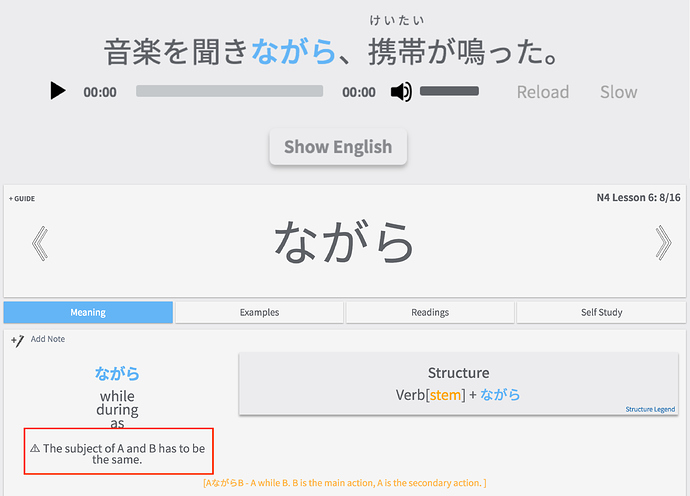I hope no one has mentioned this yet (I didn’t see) - on the example sentences for すぎる two of the sentence patterns for negative verbs or adjectives ending in い are … さすぎる. I am not seeing that in any of the example sentences. It would be nice to see that in action.
@seanblue We have returned the colors to the originals. Cheers!
@hokkaidohotrod1868 You are absolutely right! We will work on adding examples that cover these patterns. Thank you for bringing this to our attention. Cheers!
@mrnoone I don’t think this potential form sentence is good. The answer is given away in the question via 遊べない.
この公園では____けど、あそこの公園では遊べないよ。[遊ぶ]
Thanks, fixing it right now!

Ok, I have rephrased it so that it won’t give away answer on the first glance 
For てみる … is it possible to add a past tense example to this as well? てみた? Or there is one and I’m just missing it for some reason 
I promised I would start using Bunpro if you offered audio, and you now offer audio on a decent amount of items. Here I am!
Hey! 
There are examples using past tense 
Thank you and welcome on community forums! 
@mrnoone Can you update といえば in some way so that you can also find it by searching for というと or といったら?
It should be working now! 
@mrnoone For 上で, the third link explains the nuance as
Vた上でB however has strict nuances saying that A was a necessary step to come to the result B.
I think it would be good to add some information like this in the nuance section of the grammar point.
Hello 文プロ! Thanks again for the great tool. 
My apologies as I’m not sure this is the right place, but I came across an example that I don’t think is correct.
I asked a Japanese person I work with who said this was strange after I came across it. She said the sentence would sound much more natural using grammar like 〜時, 〜間に, etc.
I thought I remembered reading the rule that to use 〜ながら, the subject of both actions has to be the same. Sure enough, this is the rule that’s written on the grammar point explanation page as well.
I can’t claim to be the expert so feel free to ignore if I’m wrong! But in any case, if this is an appropriate example, it might be best to clarify the note on the grammar meaning page.
Hey! 
My apologies as I’m not sure this is the right place, but I came across an example that I don’t think is correct.
You are absolutely right 
Thank you for drawing this to our attention! As @mrnoone said, you are absolutely correct. We will get the sentence fixed immediately. Cheers!
Is it possible to add also page reference to the みなの日本語 for each grammar point, like you have done already with Genki 1?
I’m happy to support here as I have the first book second version, as I have been studying with it for some time. I just don’t want to miss out when you implement the new “Paths” feature you have on your future plans 
We will be introducing a new way to study with the textbook of your choice, called “Paths”. Starting with Genki, you will be able to study what you learn in your textbook right alongside Bunpro, chapter by chapter, grammar point by grammar point.
@Andulien Welcome to Bunpro! We already have みんなの日本語 初級I and 初級II page numbers listed in the Reading sections of their corresponding grammar points and will be making them more easily accessible (easier to reference) in the near future. Once we have Genki I & II and Tobira Paths set up, we will begin adding additional offline resources, including みんなの日本語 and others, that you can study alongside with. Stay tuned! Cheers!
Well I’ve just gone through the first three grammar points and it definitely is not consistently there. For だ it is only listing the pages for 第1版 and not the more recent version 第2版. For です and は it is not listed at all. Like I said, happy to help out with the みんなの日本語 初級I 第2版 page numbers.
@Andulien You are absolutely correct! Some of the offline resources that we have available are still incomplete and some have become outdated. We would greatly appreciate any help that you have to offer in bolstering the content on Bunpro. Thank you! Cheers!


